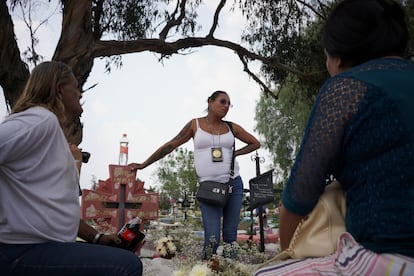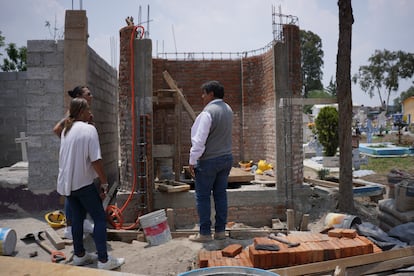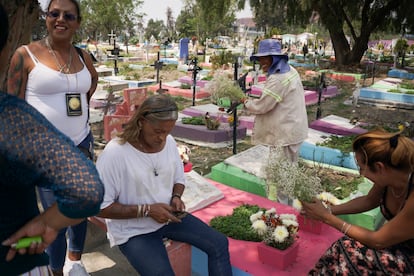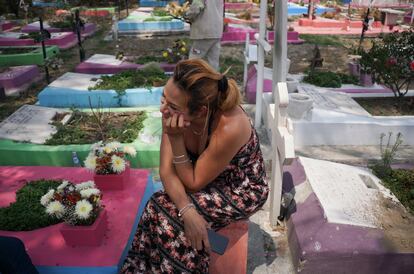The trans activist devoted to giving dignified burials to her forgotten friends: ‘I used to keep vigil all alone’
For the last seven years, Kenya Cuevas has been finding burial spots for friends. Now she is building Mexico’s first mausoleum for trans women


Death, death and more death. The first time Kenya Cuevas, Mexico’s most well-known trans activist, looked death in the eye was at the age of nine, when she ran away from home and became a prostitute on the streets of the capital. The second was when she was sent to the HIV section of Santa Marta prison, north of Mexico City, and sat by her friends as they lay dying. The prison nurses didn’t dare touch them. She would tell them, “Everything’s going to be alright. You can rest now.” She watched 200 women die like this. The third time was when her friend, Paola Buenrostro, was shot by a man who picked her up on a street corner where the two were working as prostitutes. Paola died in Kenya’s arms.
Kenya became an activist out of “pure rage” for a cause that has absorbed her whole life. She had three goals: put the alleged murderer in prison; create the first group home for trans women so they could abandon prostitution and get an education (there are now three group homes in Mexico); and have her friends buried with dignity, a much lonelier task. At first, she did it all alone with hardly any resources. She would plead for the gravediggers to work for free. Now she is building Mexico’s first mausoleum for trans women.
“And maybe the first one in the whole world,” said Kenya, as she observed progress on the mausoleum project in the San Lorenzo Tezonco cemetery in Mexico City’s Iztapalapa borough. She is wearing tight jeans, a low-cut, white tank-top, and an assortment of necklaces and rings. Two weeks ago there was a big event to kick off the construction project funded by Iztapalapa borough chief, Clara Brugada. Kenya laid the first brick of the mausoleum accompanied by Brugada and Ernestina Godoy, the Attorney General of Mexico City, who both gave speeches in support of a community that has long been marginalized and sometimes criminalized by the authorities.

After visiting the mausoleum construction site, Kenya and three friends went to visit the grave of Paola Buenrostro, who is buried a few hundred yards away. They sit down for a smoke and chat about their new projects, all the hard work ahead and how hard it is to get funding. If the conversation takes a serious turn, someone is always ready with a joke or macabre quip to lighten the mood.
Kenya doesn’t like to talk about her age and just smiled when Andrea asked, “How old were you then? Media reports put you at 78 or older.” According to Wikipedia, Kenya Cuevas is about to turn 50. Kenya laughed and said, “Wait, what are you saying? That we’re the same age?” “No, no!” Andrea protested. “We’re going to register you at the mausoleum so you can be its first occupant,” joked Kenya. “Nah, I’m going to be the last one in,” said her amused friend.
The nonchalant and playful attitude these women exhibit towards death is remarkable given they’re part of a community with an average lifespan of 40 years, according to the Inter-American Commission on Human Rights. The average life expectancy in Mexico is 75 years. In Mexico, violence against trans women is unmatched around the world; Brazil is the only other country with similar levels of anti-trans violence. According to Letra Ese, a Mexican LGBTQ+ and HIV advocacy group, there have been 461 murders of trans people in Mexico in the last five years. The consequences of addiction and living on the streets also shorten lives in the trans community.
Kenya is building a mausoleum to provide a dignified resting site. “Now they will have a beautiful and colorful place where they will be respected after everything they lived through,” she said while checking the number of tombs. It’s still missing many functional and decorative elements such as lights and stained-glass windows, but the goal is to have space for 126 coffins and cremation urns.

It’s a Thursday afternoon and the girls are chatting next to Paola Buenrostro’s grave. A cemetery worker named José Luis empties dirty water from the vases and puts in fresh flowers. “At first, I would come here all alone,” said Cuevas. “Now I send a message, and people I don’t even know come with water, coffee and bread. I feel well-supported now, but at the beginning, I came alone, alone, alone,” she said without a trace of sadness or anger. “Sometimes I kept vigil all night and pleaded in the morning for the gravediggers to work for free. They helped me a lot and didn’t charge me anything to dig the graves. And then the three of us — two gravediggers and me — would carry the coffins by ourselves and bury them.”
“Having a dignified burial should be a human right,” Kenya said, holding a cigarette between her fingers. “It’s appalling for trans women to be abused even in death.” Many of these women’s families have forgotten or rejected them. With their bodies unclaimed, they end up in mass graves. Cuevas continues to visit, bringing fresh flowers to tidy up her friends’ graves. Now, she’s able to graciously tip the gravedigger. Kenya sits in front of Paola and tells her all the latest news. “When I buried her, I promised that I wouldn’t stop fighting for us. But I was just angry then — I didn’t know I would do all this. I can’t stop thinking about how wonderful it is to keep moving forward.”

Sign up for our weekly newsletter to get more English-language news coverage from EL PAÍS USA Edition
Tu suscripción se está usando en otro dispositivo
¿Quieres añadir otro usuario a tu suscripción?
Si continúas leyendo en este dispositivo, no se podrá leer en el otro.
FlechaTu suscripción se está usando en otro dispositivo y solo puedes acceder a EL PAÍS desde un dispositivo a la vez.
Si quieres compartir tu cuenta, cambia tu suscripción a la modalidad Premium, así podrás añadir otro usuario. Cada uno accederá con su propia cuenta de email, lo que os permitirá personalizar vuestra experiencia en EL PAÍS.
¿Tienes una suscripción de empresa? Accede aquí para contratar más cuentas.
En el caso de no saber quién está usando tu cuenta, te recomendamos cambiar tu contraseña aquí.
Si decides continuar compartiendo tu cuenta, este mensaje se mostrará en tu dispositivo y en el de la otra persona que está usando tu cuenta de forma indefinida, afectando a tu experiencia de lectura. Puedes consultar aquí los términos y condiciones de la suscripción digital.
More information
Archived In
Últimas noticias
Most viewed
- Sinaloa Cartel war is taking its toll on Los Chapitos
- Oona Chaplin: ‘I told James Cameron that I was living in a treehouse and starting a permaculture project with a friend’
- Reinhard Genzel, Nobel laureate in physics: ‘One-minute videos will never give you the truth’
- Why the price of coffee has skyrocketed: from Brazilian plantations to specialty coffee houses
- Silver prices are going crazy: This is what’s fueling the rally










































